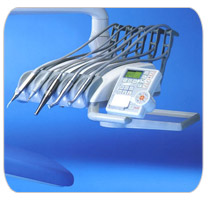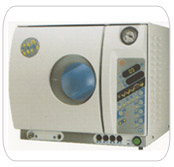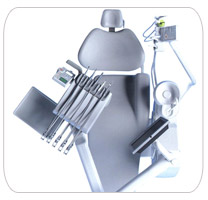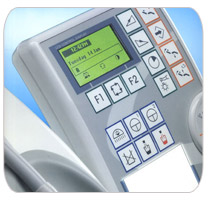Disinfection and Sterilization

1. What is disinfection and sterilization?
Disinfection and sterilization are essential for ensuring that medical and surgical instruments do not transmit pathogenic microorganisms to patients. Disinfection describes a process that eliminates many or all pathogenic microorganisms on inanimate objects. Sterilization describes a process that applies in dentistry to reduce the possibility of cross contamination by killing all bacteria, bacterial spores, and viruses found on instruments, materials, and equipment that has been exposed to a patient's body fluids and/or tissues. This is achieved through the correct utilization of sterilization methods.
2.What is decontamination?
The surface of an instrument cannot be sterilized if there is blood, saliva,other body fluids or other debris adhering to the surface. Decontamination and cleaning should precede all disinfection and sterilization processes. Cleaning involves the removal of debris as well as organic and inorganic contamination. Removal of debris and contamination
is achieved either by scrubbing with a surfactant, detergent, process (e.g., ultrasonic cleaner or washer-disinfector) using chemical agents. After cleaning,instruments should be rinsed with water to remove chemical or detergent residue, taking care to minimize splashing. Usage of physical or chemical means to remove, inactivate, or destroy pathogens on a surface or item so that they are no longer capable of transmitting infectious particles and the surface or item is rendered safe for handling, use, or disposal.
3. What is autoclave? What is pre-vacuum autoclave?
 An autoclave is an instrument used to sterilize medical equipment and supplies by subjecting them to high pressure saturated steam at high temperature. Pre-vacuum autoclaves, that are also called Class B or Type B sterilizers, use a pulse vacuum to ensure removal of air from the chamber. This is a better way of pressurizing the chamber; hence, the worker may note some slight time saving in the start-up of the pre-vacuum sterilizers. The majority of these sterilizers employ a temperature of 132°C to135°C for 3 to10 minutes to complete sterilization. This higher temperature may be improper for some objects, such as Teflon-coated instruments. The entire time needed for pressurization, sterilization, venting and drying is usually very much shorter than that for gravity sterilizers - about 45 minutes.
An autoclave is an instrument used to sterilize medical equipment and supplies by subjecting them to high pressure saturated steam at high temperature. Pre-vacuum autoclaves, that are also called Class B or Type B sterilizers, use a pulse vacuum to ensure removal of air from the chamber. This is a better way of pressurizing the chamber; hence, the worker may note some slight time saving in the start-up of the pre-vacuum sterilizers. The majority of these sterilizers employ a temperature of 132°C to135°C for 3 to10 minutes to complete sterilization. This higher temperature may be improper for some objects, such as Teflon-coated instruments. The entire time needed for pressurization, sterilization, venting and drying is usually very much shorter than that for gravity sterilizers - about 45 minutes.
4. Why is the infection control important?
Infection control is important in the practice of dentistry because dental healthcare workers and patients are exposed to a wide variety of microorganisms via blood and oral/respiratory secretions. These microorganisms may include hepatitis B virus (HBV), hepatitis C virus (HCV), human immunodeficiency virus (HIV), Mycobacterium tuberculosis, Staphylococci, Streptococci, and other viruses and bacteria.
Infections may be transmitted in the dental operatory through several routes:
 Direct contact with blood, saliva, and other secretions that are present during dental treatment procedures;
Direct contact with blood, saliva, and other secretions that are present during dental treatment procedures;
- Indirect contact with contaminated instruments, operatory equipment, or environmental surfaces;
- Contact with aerosolization of microorganisms in droplet spatter and with patient’s blood and/or saliva when using air/water sprays or high speed or ultrasonic equipment.
A set of infection-control strategies common to all health-care delivery settings should reduce the risk of transmission of infectious diseases caused by bloodborne pathogens (BBPs) such as HBV and HIV. Infected patients cannot be identified by medical history, by physical examination, or by laboratory tests. Therefore, all blood, saliva, and other patient fluids are to be considered potentially infectious for BBPs. Standard precautions must be followed routinely in the care of all dental patients.
Infection control procedures are precautions taken in healthcare settings to prevent the spread of disease. These techniques help to break the cycle of infection and to eliminate cross-contamination and are used for each and every patient to prevent the transmission of the AIDS virus and other infectious diseases. These precautions require all dental staff involved in patient care to use appropriate protective garb such as gloves, and masks and eyewear.
Infection control precautions also require all dental staff involved in patient care to use appropriate protective garb such as gloves, masks, gowns and eyewear.
All staff should be aware of infection control procedures and understand why they are necessary. New staff must be appropriately trained before undertaking decontamination duties. All dental staff working in a clinical environment are reminded of the main risks of infection i.e. through sharps injuries, aerosol spray from high speed hand pieces, triple syringes, ultrasonic scalers and the routes of infection through eyes, mouth, nose and skin abrasions.
 5. What infection control techniques are practiced in your dental office?
5. What infection control techniques are practiced in your dental office?
• We take infection control seriously in our dental clinic and follow a strict sterilization protocol each day.
• We use a wide range of disposable items like paper glass, saliva ejector, fluoride trays, disposable air/water syringe tips etc. in the dental office for reducing the risk of cross-contamination.
• After each patient visit, the used gloves are discarded, hands are washed and a new pair of gloves is used for the next patient.
• Disposable items like needles or gauze are placed in special bags or containers. Sharp items and anything contaminated with blood or saliva are disposed of in special containers.
• After each patient, disposable wear like the gloves and masks are discarded. Before seeing the next patient, the treatment team washes their hands and put on a new pair of gloves and masks.
• Before the patient enters the operating room, all surfaces, such as the dental chair, dental light, drawer handles and countertops have been cleaned and decontaminated.
• The used non disposable dental instruments are cleaned by hand prior to Class B type autoclave sterilization. Instruments are pre-bagged before they are sterilized, and these sterile packets are not opened again until the patient is seated and the instruments are needed for a procedure. This "closed packet" system provides the utmost in quality sterilization.
• We cover dental light handle and switch, dental chair handle, and dental chair panel with protective covers, which are replaced after each patient.
•We use disposable air/water system and disposable air/water syringe tips for reducing the risk of cross-contamination.
• Non-disposable items like the dental tools or handpieces are cleaned and sterilized between patients.
• The water lines are flushed after each patient to remove any contaminants that may have been retracted into them.
A MODERN SYSTEM THAT COMPLIES WITH EUROPEAN STANDARDS- The dental chair that we use in our dental clinic: Hygiene means safety - safety inside and outside the
dental unit, for the dentist, the assistant and the patient. It
also means ensuring perfect hygiene in the building mains
water system by preventing backflow contamination.
Anthos Cisar Evolution features integrated disinfection systems with maximum efficiency, practicality and ease of use:
 1. WHE (Water Hygienisation Equipment) :
1. WHE (Water Hygienisation Equipment) :
An automatic system that ensures permanent disinfection
of spray and water-to-cup circuits via the UV light to inhibit the formation of biofilm.
2. Bioster: Automatic disinfection system for spray water circuits. The simplicity of an automatic system that makes end-of-work sanitising procedures extremely simple and guarantees disinfection of spray water and rinse circuits even after the dental unit has been idle for a long period. The practical instrument holder utilised on the cuspidor bowl also makes disinfection procedures easier.
3. AWSSDS (Automatic Suction System Wash and Sanitising Device):
Device for rapid wash cycles and subsequent disinfection of the suction system (via liquid drawn from dedicated tank).
4. O.D.R. spray anti-retraction system: Device fitted on all dynamic instruments: blocks droplet retraction completely and prevents backflow contamination of spray circuits.
5. Distilled water tank: This system ensures quality and conformity with water supply hygiene requirements independent of drinking water quality. The 2-litre bottle incorporated on the unit body can be removed for easy filling and sanitisation.
• We use Faro Step Class B Autoclave in our dental clinic. Class B autoclaves incorporate better steam penetration through fractionated pre-vacuum technology and can be used for every type of instrument (including hollow instruments like dental handpieces).
Fractioned vacuum system ensures virtually total expulsion of chamber air to create optimal sterilization conditions with Faro Step Class B Autoclave.
• Disposable contaminated sharps are discarded immediately or as soon as possible after their use. They are placed into yellow containers that meet the standards for sharps. Other regulated medical waste are placed in red containers that are suitable. These medical waste are being handled by Goverment of Kadikoy Medical Waste Unit who regularly visits our clinic every other Tuesdays.
Sources
http://www.ada.org/2697.aspx
http://www.sdaa.sk.ca/Workplace%20Issues/Health&Safety.pdf/CDA-InfectionControlManual2006.pdf
http://www.sfieducation.net/resources/Infection%20Control%20in%20Dentistry-Definitions.pdf
http://www.southstaffordshirepct.nhs.uk/policies/clinical/IC_in_Dentistry_ProtocolSept2009.pdf





